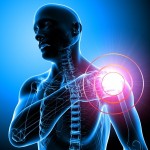 Injuries to the rotator cuff may occur for several reasons. It may be injured from a sudden fall or while attempting to lift a heavy object. Rotator cuff tears are common among athletes, such as baseball pitchers or tennis players who need to continuously raise their arms during play. Shoulders also become more prone to this type of injury as your shoulder muscles and tendons begin to deteriorate as you age.
Injuries to the rotator cuff may occur for several reasons. It may be injured from a sudden fall or while attempting to lift a heavy object. Rotator cuff tears are common among athletes, such as baseball pitchers or tennis players who need to continuously raise their arms during play. Shoulders also become more prone to this type of injury as your shoulder muscles and tendons begin to deteriorate as you age.
Anatomy of the Rotator Cuff
As a ball-and-socket joint, the shoulder is made up of three bones:
- Scapula (shoulder blade)
- Clavicle (collarbone)
- Humerus (upper arm bone)
The arm bone is held into the shoulder socket by four muscles that join as tendons to cover the head of the humerus to form the rotator cuff. The rotator cuff assists with lifting and rotating the arm. Located in the area between the rotator cuff and the acromion (top shoulder bone) is the bursa. The bursa is responsible for providing lubrication to this area so that the tendons of the rotator cuff can glide freely while moving your arm.
Diagnosing a Rotator Cuff Tear
When diagnosing a rotator cuff tear, Dr. Marans will press on different areas on your shoulder and move your arm into various positions. Pain or limited range of motion may indicate a torn rotator cuff. The Doctor will test the strength of your shoulder muscles or arms by asking you to push up or down against his hand.
Diagnostic tests, such as X-rays or an MRI may be ordered to determine if a rotator cuff tear has occurred. While an X-ray cannot show a tear in the rotator cuff, it can show bone spurs, which can be a sign of a rotator cuff problem. It may also show other problems, including osteoarthritis that could be causing pain in the shoulder. A MRI is the best option for viewing a tear and to determine its severity.
Treating Rotator Cuff Tears
For minor tears, Dr. Marans may recommend a conservative approach. Often, a rotator cuff tear can treated by:
- Resting from physical activity
- Icing the shoulder
- NSAIDs to help reduce inflammation and relieve pain
- Physical therapy and exercises to improve range of motion and muscle strength
Surgical Options or Treating Rotator Cuff Tears
For complete tears in the rotator cuff, surgery may be indicated. Rotator cuff tears can often be repaired with arthroscopic surgery. Arthroscopic surgery has a shorter recovery time with less scarring. Using small incisions, Dr. Marans can make repairs to a rotator cuff tear by reattaching the tendon to the bone and removing bone spurs if needed. For severe tears, open surgery may be required to replace a tendon or in extreme cases, to perform shoulder replacement surgery.
Leading Orthopedic Surgeon for Rotator Cuff Tears
For over 20 years, Dr.Howard Marans has been the leading orthopedic surgeon for treating rotator cuff tears in the Orange County area. Do not delay treatment for your shoulder injury. Call us at 714.979.8981 or click below to schedule your appointment today.


